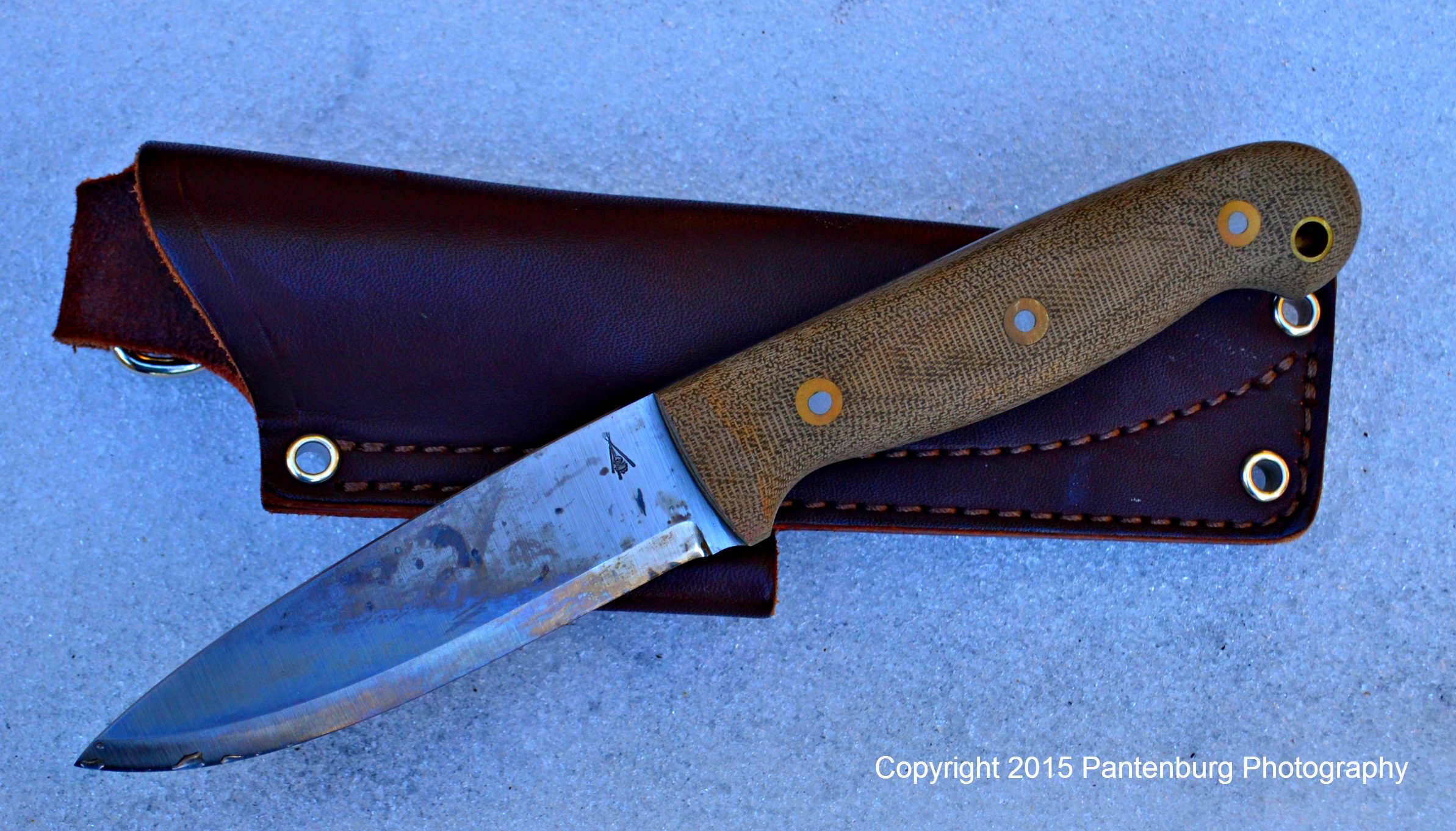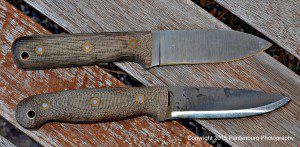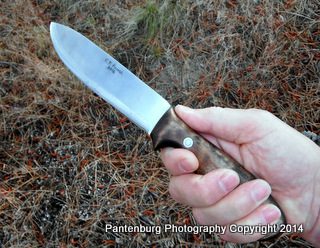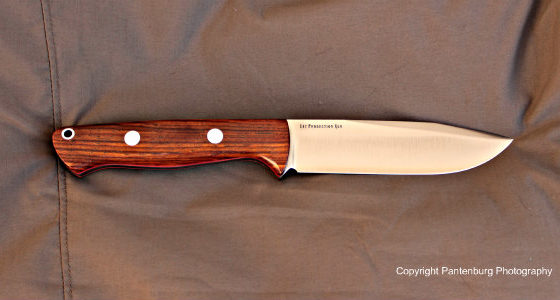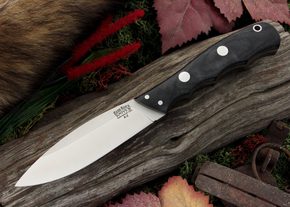L.T. Wright Handcrafted Knives has a new bushcrafter out, and it promises to be a contender in that elusive, almost-mythical best all-around knife category.
by Leon Pantenburg
I bought this knife to test, and was not paid to do this review.
L.T. Wright Handcrafted Knives began when L.T. Wright and a friend began Blind Horse Knives. A few years back, the two decided to part ways and do their own designs and manufacturing. Wright decided to design knives based on functionality, as well as good looks.
The result was some good looking knives that are designed to be used hard.
I had already checked out the L.T. Wright Genesis, a Kephart design bushcrafter. I really like it, and when the GNS (which means “Go, No Show”) came on the market I decided to add another knife to my nearly-out-of-control bushcrafter collection.
Designed by Self Reliance Illustrated, the GNS is handcrafted from O-1 Tool Steel and finished with a number of tough, durable handle materials. Large fish eye bolts and a lanyard hole compliment the tapered and contoured handle (some models feature a Bead Blasted Handle). The GNS is ground with either a Scandi Grind or a Saber Grind. The GNS comes with a handcrafted leather dangler sheath, with double stitching and a 3/8″ fire steel holder.
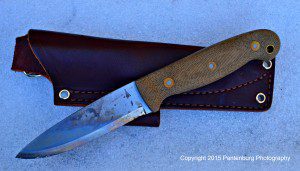
The GNS by L.T. Wright Knives is designed to be a working knife that can handle all your bushcrafting needs.
Here are the GNS specifications:
- Overall Length: 9.5″
- Blade Length: 4.5″
- Sharpened Edge: 4.25″
- Handle Length: 5″
- Thickness: 1/8″
- Steel: O-1 Tool Steel
- Handle Material: Green Canvas Micarta
The good stuff:
The Handle: A knife’s handle is really, really important. One that doesn’t fit may be dangerous and may twist while you’re using it, causing a loss of blade control. You really don’t want to make a survival situation worse by cutting yourself!
I ordered the green micarta bead blasted handle on my GNS, because the material reminds me of the weathered wood pilings along the Mississippi River channel. And it matches my Genesis. My experience with micarta is that the material gets almost tacky when wet. This is a great attribute for a knife that will probably get blood, visceral material, fish scales or slime on it. With fishing season coming soon, that is a consideration on any knife I might take on an outing.
The handle itself is five inches long, which is wonderful. The most common knife complaint I heard at a meeting of the Marion County Search and Rescue Team last year was that handles are too short. I wear size large gloves, and my right palm measures four inches across. That means many otherwise great knives don’t work for me.
Also, in bitter cold like we sometimes get in Central Oregon, I want a knife that can be used while wearing gloves.
The handle’s design is contoured so there are no hot spots when using it for extended periods. I’ve loaned out the GNS to people with smaller hands, and they have been able to use it very successfully.
Steel: I love the 0-1 tool steel in the GNS. It holds an edge really well, and is easy to resharpen. All L.T. Wright knives come from the factory shaving-sharp, and they stay that way through a lot of use. The nice thing about 0-1 is that it is high quality stuff, but not so expensive that it prices itself out of the reach of most people.
A patina will probably build up after the blade has been used a while. I have noticed some staining already in both my GNS and Genesis. On the GNS, the discoloration came from slicing tomatoes and trimming meat. On the Genesis, the stains came from cleaning fish, cutting meat, whittling pitch wood and various bushcraft tasks.
I own and appreciate pretty knives that appear pristine. But I’m a user, not a collector, and I actually like seeing honest evidence of use. It shows the tool is used and appreciated.
Besides, the only way to keep a knife looking like new is to never use it, and for me, that’s not going to happen. I tried a vinegar and lemon juice mixture to force a patina and both the Genesis and GNS came out looking really good!
The Blade
Spine: The 90-degree angles mean that the spine is sharpened like an ice skate. I use such a spine all the time for processing tinder and scraping pitchwood. The spine also works for scraping a ferrocerrium rod to create sparks for firemaking.
Grind: I like a Scandinavian grind for a bushcraft knife. The scandi grind is easy to re-sharpen for beginners, and maintaining a razor edge doesn’t require much effort. I wouldn’t own a knife I couldn’t easily sharpen. (Check out these sharpening videos.)
Point: The drop point is a good choice for a bushcraft/utility knife. It works well for just about everything, and is a point that will also excel as a hunting knife. Check out these other knife points.
Blade thickness: At 1/8-inch thick, the thickness is about right. I don’t like thick blades, and for the most part, I think thickness is more of a fashion statement than anything else. You don’t need a thick blade on most outdoors knives unless the blade is made of really crappy steel. The GNS has a good compromise between strength and slicing ability.
Belly: The belly is that curved part that does most of the work when there is skinning to be done. Though this is not specifically a hunting knife, the nice curve near the tip would prove to be useful for dressing out a big game animal. It works well for gutting and beheading fish.
Sheath: This is my second dangler sheath from L.T. Wright Knives, and I really like the design. A dangler is safer, IMO, because it moves with the wearer. You are less likely to accidentally stab yourself with such a setup. The sheath material is top grain leather.
I particularly like how the lanyard hole and a grommet hole at the corner of the sheath work together. In a canoe or boat, I’ll run a piece of paracord through both of those holes and tie a knot to secure the knife to the sheath. (I lost a Mora knife in some whitewater rapids a few years back, and am now forever paranoid.)
Made in the U.S.A.: All L.T. Wright knives are handmade in Wintersville, Ohio. Call the factory, and someone with a midwestern accent will answer the phone. When you support an American small business, that means the business, factory and workers pay taxes and contribute to the local economy. Support American craftsmen!
Warranty: All L.T. Wright cutlery comes with a 100 percent lifetime warranty.
In the final analysis, you will have to look a long time to find a better bushcraft knife than the GNS. It is just about perfect, as far as I can tell, and at $160, well within the reach of most of us. Mine will be getting a lot of use.
Please click here to check out and subscribe to the SurvivalCommonSense.com YouTube channel, and here to subscribe to our weekly email update – thanks!

